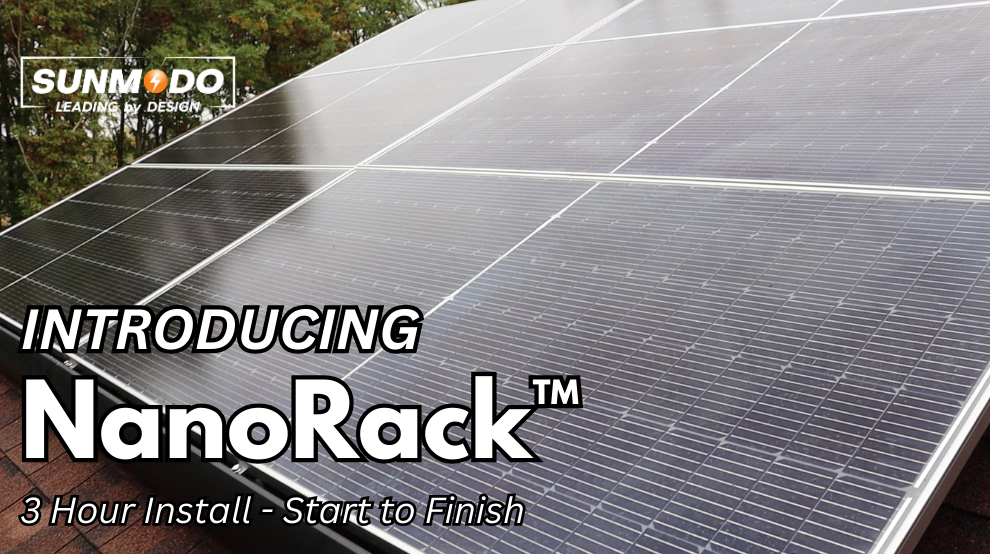Originally Posted In: Solar Builder – How NanoRack simplifies rail-less roof mount installs | The Pitch | Solar Builder (solarbuildermag.com)
Authored By: Chris Crowell | February 26
An efficient rooftop solar installation often starts on the ground, and SunModo’s new NanoRack mounting solution promises more on-the-ground assembly than ever. NanoRack allows for fast installation, and it reduces the chances for errors and misalignment, which helps less experienced crews get up to speed quickly. Steve Mumma, CEO of SunModo, explains this episode of The Pitch.
- 0:27 – How NanoRack is different from other rail-less systems
- 1:41 – Step by step installation of NanoRack (mostly on the ground)
- 3:03 – Why haven’t we always done it this way?
- 4:16 – What is average speed of installation?
- 5:22 – How NanoRack helps less experienced crews
- 7:06 – Feedback from solar installers so far?
- 9:10 – Next steps for NanoRack?
Watch the full 10-min chat in the video above. Part of the transcript is below.
Crowell: I keep seeing that you’re noting that NanoRack doesn’t have rail, but it isn’t rail-less, or you don’t want to term it that way. I’m curious why you’re drawing that distinction?
Mumma: Yeah, on the surface that doesn’t make sense, and we recognize that. What we’re trying to do there is say that NanoRack does not have rail — at all — so by definition it’s a rail-less system. But the distinction we’re trying to make is that rail-less systems to date have not been broadly accepted. They’re used by primarily the larger national installers who like it for the logistics reasons, but in my almost six years in solar, I’ve talked to a lot of installers and many of them have tried all of the rail-less systems that have come out, and they go back to rail because those rail-less systems require just a level of precision, a lot of measuring, and they’ve got a steeper learning curve.
It just hasn’t worked for those types of installers, and with NanoRack, we have addressed those issues. Our initial feedback is that all these people that have tried rail-less, and didn’t like it, they love NanoRack.
Crowell: Let’s get into that. So, I’m an installer who says I’ve tried the more typical rail-less approach and maybe the learning curve was too steep, or I couldn’t get adjusted to it. What’s your pitch back to me? What are you doing differently here?
Mumma: The two main things that I always heard from people that said they tried rail-less and hated it are: the level of precision required on the roof because each mount has to be pretty precisely located, and there’s always some adjustment. You’ve really got to plan ahead and locate all those mounts properly. So, that’s number one.
The second is wire management. The big way we’ve addressed those concerns is just simply to take most of the installation work off of the roof. Everything gets attached to the modules on the ground before you set foot on the roof. As a result, that helps the wire management a lot because, before the module goes up to the roof, the MLPE are attached — everything’s pre-attached to the module frames, and makes it so you simply have to put things together. In addition to that, by attaching everything on the ground, the only real measurement you have to do on the roof is to just locate the leading edge of modules. Everything after that just all clicks together.
Crowell: Seeing the steps in the video, it made me wonder why we haven’t always done it this way? Were there some engineering challenges that you needed to overcome?
Mumma: Part of it is just habit. As industries grow and evolve, we end up getting in a box of, ‘Well, this is how we do things. We have clamps that squeeze the module down. We do the work on the roof.’ Innovation becomes iteration as opposed to true Innovation. At SunModo over these last four to five years, we prided ourselves on trying to step all the way out and find other, better ways to do things. We’re certainly not the first to attach to the bottom of a module; we’re certainly not the first to have tried to do some of the work on the ground. I do think we’ve committed to it and gone further than anybody else has in an effort to just push that envelope in terms what’s possible.
Crowell: Prior to the launch of NanoRack, you mentioned that one of the big benefits of this new system you were developing would be its speed of installation. Now that it’s on the market being installed on rooftops, I’m curious the kind of the results you’re seeing.
Mumma: We had very high expectations for the speed, but you don’t know for certain how something’s actually going to go on the roof until it goes on the roof. And … we’ve found that it’s even faster than what we expected. What we’re seeing from installers is a a 25 to 30 module system can be installed in between 2 and 3 hours start to finish. The genuinely exciting part of that is since NanoRack is still relatively new, a lot of that real world data is coming from people that are installing the system for the first time. So they’re at the very beginning of that learning curve.
Crowell: And like you said, if there is a system that’s comparable, maybe it takes a while to get a really seasoned crew with that system, versus starting out right out of the gate.
Mumma: That’s definitely one of the additional benefits that we were hoping for, is just how easy it is to pick up. Because you’re just doing a lot less stuff on the roof, there’s a lot less measuring, and every measurement is an opportunity for error. When we’re able to take a lot of that out of the process, it just really makes the process easier to pick up. Basically, with the NanoRack installation process, there’s two different types of modules to build on the ground: there’s one sort of configuration for all leading edge modules, and there’s another configuration for every trailing module. You locate your leading edge modules and everything else just flows from that.
Crowell: Ease of installation is an important note as much if not more than the speed aspect of it, just considering the issue of finding qualified solar installers.
Mumma: One of the challenges that installers tell us, especially the ones that are growing and scaling, is adding new crews, and finding high quality people to be on the roof is not always easy. So, from our perspective, anything we can do to make that process easier for them … rather than having a crew that consists of four people that are really well trained, with NanoRack, you really can have a crew that’s one person who really knows what they’re doing, and then the rest are just sort of attaching things and hauling it to the roof.


